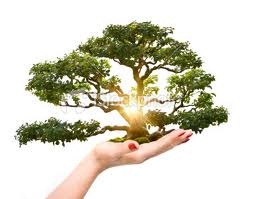 One of the most important aspects of your bonsai is the age. Not the actual age of your bonsai, but what age your bonsai appears to be. As far as aesthetics are concerned, it is important that your bonsai appears far more aged than it actually is. If you are able to create the appearance of a 500 year-old pine with a 5 year old bonsai, then you are surely well regarded and envied by the majority of your peers.
One of the most important aspects of your bonsai is the age. Not the actual age of your bonsai, but what age your bonsai appears to be. As far as aesthetics are concerned, it is important that your bonsai appears far more aged than it actually is. If you are able to create the appearance of a 500 year-old pine with a 5 year old bonsai, then you are surely well regarded and envied by the majority of your peers.
When you attempt to age your bonsai you want it to have certain characteristics, such as: tight, fine foliage; bark with fractures; branches that are open with angular bends; and a domed (as opposed to pointed) crown. Starting with a bonsai plant that already has some or all of these attributes–like old yamadori–is the quickest way, but they have their drawbacks as well. You will have to perform heavy cutting and carving to hide the removal of the heavier branches and diminish the size. This is incredibly difficult to do well, and if done incorrectly, can never be rectified. The fact that new branches grown and trained by the bonsai artist always appear more juvenile, thus complicating the matter further.
There are some techniques you can use to advance to apparent age of our bonsai, though. Some do take more time than others to have an effect.
First you must make sure that you understand what is being referred to when describing the appearance of age in bonsai. These can be broken down into five main characteristics:
1. A domed crown
2. The poise of the branches
3. Angular branch ramification
4. Distinct, separated foliage ‘clouds’
5. Mature bark texture
THE BONSAI CROWN
When you look at trees that are hundreds of years old you should notice that they all carry a common trait: a domed crown. In order to create a domed crown for your bonsai you will need to dispose of the concept of "wiring a new leader". The leader should have been grown and shaped while the trunk was being developed. Once the trunk is finished all thoughts of the leader are abandoned. The apex of your bonsai should now be thought of as an apical, central branch. It should be constructed the same as any other branch, however, the limb supporting the apical branch structure will approach from below instead of from a side.
BONSAI BRANCH POISE
The principles of branch positioning are relatively easy to follow, but often it is compromised in the beginning as you rush for a finished image. The old broadleaved branches are generally horizontal and old conifer branches tend to sweep downward–in the simplified world of bonsai. You must remember that arching branches will not convey the impression of age. Most artist do not realize this until years later when the branches have set and are to thick to change. The key to bonsai branch poise is the get the branches correct at the outset.
ANGULAR BRANCH RAMIFICATION
Some bonsai have fine ramification and some bonsai have really fine ramification. A broom style bonsai could have millions of well-packed, miniature shoots, look well-developed and mature, but never appear ancient. It just is not that kind of image. So, ramification by itself will not give the bonsai a look of age, but the way the branches ramify does. Dramatic taper, sharp angles, switch-backs, these are all indicative of bonsai age. Restricting short foliage bearing shoots to the periferal areas, lacking thin laterals growing from the inner portion of the limbs, and short distances between the ends and forks also contribute. Old trees do not have branches forming a triangular framework, nor do they have pointed apices. These branches should be cut back at the earliest opportunity. Every time you prune or wire your bonsai you should consider these points. No matter what age or stage of development your bonsai is in, there are always opportunities to improve.
FOLIAGE CLOUDS
Foliage on a mature bonsai can become one solid mass without proper attendance. As trees reach an older age, the foliage masses will become more isolated and sparse. The individual "clouds" will start to fragment, seeming to consist of multiple smaller clouds. Take the time to study your well developed and more established bonsai. Do you think removing one or two branches, or even thinning out the clouds to fragment them will improve both the image and apparent age of your bonsai?
BARK TEXTURE
The most precious feature of any bonsai is undeniably mature textured bark. Without it, few bonsai can appear mature. There are some exceptions such as acers. taxus, fagus, etc., because the bark stays smooth throughout the tree’s life. Most species, however, will create a characteristic mature bark as they mature, getting a plated or fissured texture. Some, like pseudocydonia and platanus have bark that flakes in patches revealing shades of pink, buff, and green. Betula and most prunus species all their bark to peel, displaying many colorful layers.

Deprecated: strpos(): Passing null to parameter #1 ($haystack) of type string is deprecated in /home/agriviek8Qv/agriviet.net/public_html/wp-includes/comment-template.php on line 2522